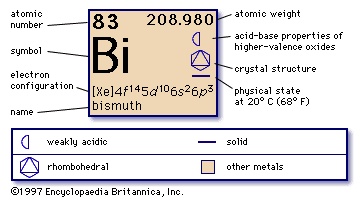bismuth
chemical element
 the most metallic and the least abundant of the elements in the nitrogen family (Group Va of the periodic table).
the most metallic and the least abundant of the elements in the nitrogen family (Group Va of the periodic table).Bismuth is the most diamagnetic of all metals (i.e., it exhibits the greatest opposition to being magnetized) and has the lowest thermal conductivity of all metals except mercury. It is hard, brittle, lustrous, and coarsely crystalline. It can be distinguished from all other metals by its colour—gray-white with a reddish tinge. Bismuth was first described in 1450 by Basil Valentine, a German monk.
Bismuth is often found free in nature. It also occurs in compounds: as the sulfide bismuthinite, or bismuth glance (Bi2S3); the oxide bismite (Bi2O3); and the carbonate bismutite (BiO)2CO3. Bismuth is frequently associated with ores of tin, lead, or copper, from which it is separated as a by-product during their refining. Pure bismuth can also be obtained by reducing the oxide with carbon or by roasting the sulfide in the presence of charcoal and metallic iron to remove the sulfur.
Although it does not tarnish in air at ordinary temperatures, bismuth forms an oxide coating when heated. The yellow colour of this oxide distinguishes it from those formed by other metals. At red heat, bismuth reacts with steam, but it is not affected by cold, air-free water; it combines directly with sulfur and with the halogens (fluorine, chlorine, bromine, iodine). The element is not attacked by hydrochloric acid, and only slightly by hot sulfuric acid, but it is rapidly dissolved by either dilute or concentrated nitric acid.
Like antimony and water, bismuth expands slightly upon solidifying, a property that renders bismuth alloys particularly suited to the manufacture of sharply detailed metal castings. Because the alloys have low melting points, they are used in special solders as well as in automatic sprinkler heads, fire-door release lines, fuses, safety plugs for compressed-gas cylinders, and many other fire-detection devices. Thermoelectric equipment for refrigeration uses bismuth telluride (Bi2Te3) and bismuth selenide (Bi2Se3). The principal chemical application of the element is in the form of bismuth phosphomolybdate (BiPMo12O40), a highly effective catalyst for the air oxidation of propylene and ammonia to acrylonitrile, which is used to manufacture acrylic fibres, plastics, and paints. Salts of bismuth frequently are used in soothing agents for the treatment of digestive disorders, in outlining the alimentary tract during X-ray examination, and in treating injuries and infections of the skin. The oxychloride BiOCl has been used to impart a pearlescent quality to lipstick, nail polish, and eye shadow. For comparative statistical data on bismuth production and reserves, see mining (table).
atomic number
83
atomic weight
208.980
melting point
271.3 °C (520.3 °F)
boiling point
1,560 °C (2,840 °F)
density
9.747 g/cm3 at 20 °C (68 °F)
oxidation states
+3, +5
electron config.
1s22s22p63s23p63d104s24p64d104f 145s25p65d106s26p3
- Titicaca, Lake
- Titius, Johann Daniel
- Title IX
- Title of Pericope
- titmouse
- Tito, Josip Broz
- Tito Puente
- Titov, Gherman Stepanovich
- titration
- Ti-ts'ang
- Tits, Jacques
- Titulescu, Nicolae
- Titus
- Titus Andronicus
- Titus Annius Milo
- Titus Oates
- Titus Pomponius Atticus
- Titus Quinctius Flamininus
- Titus, Saint
- Titus Tatius
- Titus, The Letter of Paul to
- Titusville
- tityra
- Tiv
- Tivadar Csontváry-Kosztka